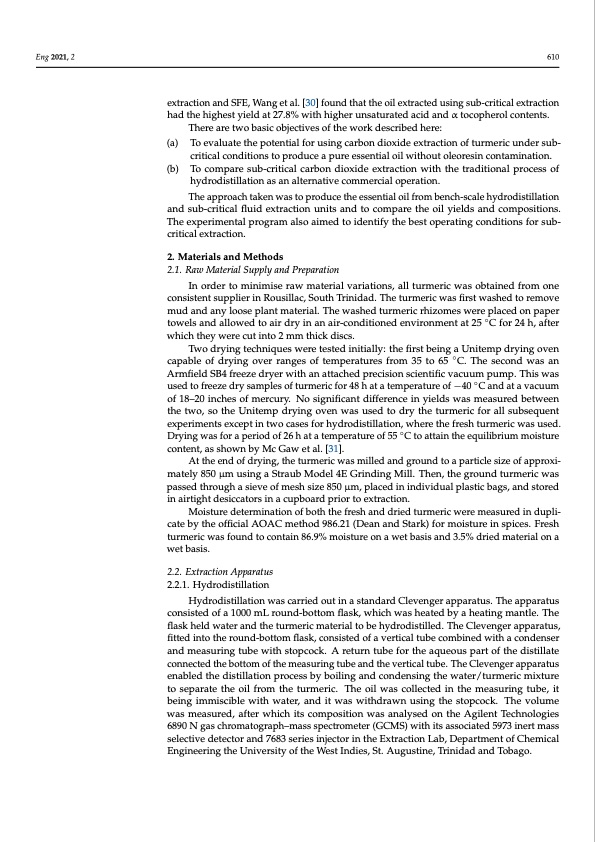
PDF Publication Title:
Text from PDF Page: 003
Eng 2021, 2 610 extraction and SFE, Wang et al. [30] found that the oil extracted using sub-critical extraction had the highest yield at 27.8% with higher unsaturated acid and α tocopherol contents. (a) (b) There are two basic objectives of the work described here: To evaluate the potential for using carbon dioxide extraction of turmeric under sub- critical conditions to produce a pure essential oil without oleoresin contamination. To compare sub-critical carbon dioxide extraction with the traditional process of hydrodistillation as an alternative commercial operation. The approach taken was to produce the essential oil from bench-scale hydrodistillation and sub-critical fluid extraction units and to compare the oil yields and compositions. The experimental program also aimed to identify the best operating conditions for sub- critical extraction. 2. Materials and Methods 2.1. Raw Material Supply and Preparation In order to minimise raw material variations, all turmeric was obtained from one consistent supplier in Rousillac, South Trinidad. The turmeric was first washed to remove mud and any loose plant material. The washed turmeric rhizomes were placed on paper towels and allowed to air dry in an air-conditioned environment at 25 ◦C for 24 h, after which they were cut into 2 mm thick discs. Two drying techniques were tested initially: the first being a Unitemp drying oven capable of drying over ranges of temperatures from 35 to 65 ◦C. The second was an Armfield SB4 freeze dryer with an attached precision scientific vacuum pump. This was used to freeze dry samples of turmeric for 48 h at a temperature of −40 ◦C and at a vacuum of 18–20 inches of mercury. No significant difference in yields was measured between the two, so the Unitemp drying oven was used to dry the turmeric for all subsequent experiments except in two cases for hydrodistillation, where the fresh turmeric was used. Drying was for a period of 26 h at a temperature of 55 ◦C to attain the equilibrium moisture content, as shown by Mc Gaw et al. [31]. At the end of drying, the turmeric was milled and ground to a particle size of approxi- mately 850 μm using a Straub Model 4E Grinding Mill. Then, the ground turmeric was passed through a sieve of mesh size 850 μm, placed in individual plastic bags, and stored in airtight desiccators in a cupboard prior to extraction. Moisture determination of both the fresh and dried turmeric were measured in dupli- cate by the official AOAC method 986.21 (Dean and Stark) for moisture in spices. Fresh turmeric was found to contain 86.9% moisture on a wet basis and 3.5% dried material on a wet basis. 2.2. Extraction Apparatus 2.2.1. Hydrodistillation Hydrodistillation was carried out in a standard Clevenger apparatus. The apparatus consisted of a 1000 mL round-bottom flask, which was heated by a heating mantle. The flask held water and the turmeric material to be hydrodistilled. The Clevenger apparatus, fitted into the round-bottom flask, consisted of a vertical tube combined with a condenser and measuring tube with stopcock. A return tube for the aqueous part of the distillate connected the bottom of the measuring tube and the vertical tube. The Clevenger apparatus enabled the distillation process by boiling and condensing the water/turmeric mixture to separate the oil from the turmeric. The oil was collected in the measuring tube, it being immiscible with water, and it was withdrawn using the stopcock. The volume was measured, after which its composition was analysed on the Agilent Technologies 6890 N gas chromatograph–mass spectrometer (GCMS) with its associated 5973 inert mass selective detector and 7683 series injector in the Extraction Lab, Department of Chemical Engineering the University of the West Indies, St. Augustine, Trinidad and Tobago.PDF Image | Sub-Critical Fluid Extraction Turmeric vs Hydrodistillation

PDF Search Title:
Sub-Critical Fluid Extraction Turmeric vs HydrodistillationOriginal File Name Searched:
eng-02-00038.pdfDIY PDF Search: Google It | Yahoo | Bing
CO2 Organic Rankine Cycle Experimenter Platform The supercritical CO2 phase change system is both a heat pump and organic rankine cycle which can be used for those purposes and as a supercritical extractor for advanced subcritical and supercritical extraction technology. Uses include producing nanoparticles, precious metal CO2 extraction, lithium battery recycling, and other applications... More Info
Heat Pumps CO2 ORC Heat Pump System Platform More Info
| CONTACT TEL: 608-238-6001 Email: greg@infinityturbine.com | RSS | AMP |